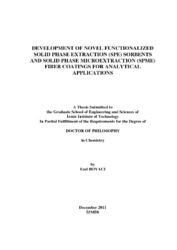Please use this identifier to cite or link to this item:
https://hdl.handle.net/11147/2904Full metadata record
| DC Field | Value | Language |
|---|---|---|
| dc.contributor.advisor | Eroğlu, Ahmet Emin | en |
| dc.contributor.author | Boyacı, Ezel | - |
| dc.date.accessioned | 2014-07-22T13:48:35Z | - |
| dc.date.available | 2014-07-22T13:48:35Z | - |
| dc.date.issued | 2011 | en |
| dc.identifier.uri | http://hdl.handle.net/11147/2904 | - |
| dc.description | Thesis (Doctoral)--İzmir Institute of Technology, Chemistry, İzmir, 2011 | en |
| dc.description | Includes bibliographical references (leaves: 166-179) | en |
| dc.description | Text in English; Abstract: Turkish and English | en |
| dc.description | xxi, 179 leaves | en |
| dc.description | Full text release delayed at author's request until 2015.01.15 | en |
| dc.description.abstract | In the first part of the study, amino-, mercapto- and bifunctional silica-based solid phase extraction (SPE) sorbents were developed, characterized and utilized for sorption and speciation of inorganic As(III)/As(V). Critical parameters on sorption and desorption of species were investigated. The proposed methodology was validated through the analysis of a standard reference material. The subsequent studies were concentrated on the transfer of the experience gained during the modification of silicate surface for preparation of SPE sorbents to the preparation of SPME coatings. The second part of the thesis includes the development, characterization and use of solid phase microextraction (SPME) fibers for the speciation of inorganic and organometallic arsenic compounds. SPME fiber coatings have been prepared by two routes, namely, sol-gel synthesis and nanoparticle immobilization. Fibers having amino functionality synthesized through the sol-gel process were used in the speciation of As(III), As(V), monomethyl arsonic acid (MMA) and dimethyl arsinic acid (DMA). HPLC-HGAAS or HPLC-ICPMS was used in the measurements. Speciation of arsenic compounds was also realized using SPME fibers modified with zero valent iron nanoparticles embedded into an agarose matrix. The detection of the solid phase microextracted analytes was realized by HPLC-ICPMS. Prepared fibers have shown superior extraction for arsenicals. The effect of several parameters on the extent of extraction of arsenic species; namely, solution pH, extraction time, agitation speed and ionic strength were investigated. Validity was checked via the application of the proposed methodology on real samples (tap water, bottled water and geothermal water, urine samples) and standard reference materials. | en |
| dc.language.iso | en | en_US |
| dc.publisher | Izmir Institute of Technology | en_US |
| dc.rights | info:eu-repo/semantics/openAccess | en_US |
| dc.subject.lcsh | Extraction (Chemistry) | en |
| dc.subject.lcsh | Chemistry, Analytic--Technique | en |
| dc.subject.lcsh | Coating processes | en |
| dc.title | Development of novel functionalized solid phase extraction (SPE) sorbents and solid phase microextraction (SPME) fiber coatings for analytical applications | en_US |
| dc.type | Doctoral Thesis | en_US |
| dc.authorid | 0000-0003-4391-4833 | - |
| dc.department | Thesis (Doctoral)--İzmir Institute of Technology, Chemistry | en_US |
| dc.relation.publicationcategory | Tez | en_US |
| item.languageiso639-1 | en | - |
| item.fulltext | With Fulltext | - |
| item.openairecristype | http://purl.org/coar/resource_type/c_18cf | - |
| item.openairetype | Doctoral Thesis | - |
| item.grantfulltext | open | - |
| item.cerifentitytype | Publications | - |
| Appears in Collections: | Phd Degree / Doktora | |
Files in This Item:
| File | Description | Size | Format | |
|---|---|---|---|---|
| 421371.pdf | DoctoralThesis | 25.44 MB | Adobe PDF |  View/Open |
CORE Recommender
Page view(s)
174
checked on Jul 22, 2024
Download(s)
120
checked on Jul 22, 2024
Google ScholarTM
Check
Items in GCRIS Repository are protected by copyright, with all rights reserved, unless otherwise indicated.